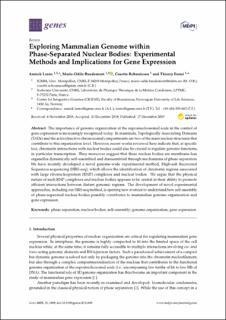| dc.contributor.author | Lesne, Annick | |
| dc.contributor.author | Baudement, Marie-Odile | |
| dc.contributor.author | Rebouissou, Cosette | |
| dc.contributor.author | Forne, Thierry | |
| dc.date.accessioned | 2020-07-10T11:56:11Z | |
| dc.date.available | 2020-07-10T11:56:11Z | |
| dc.date.created | 2020-01-23T11:40:09Z | |
| dc.date.issued | 2019 | |
| dc.identifier.citation | Genes. 2019, 10 (12), . | en_US |
| dc.identifier.issn | 2073-4425 | |
| dc.identifier.uri | https://hdl.handle.net/11250/2663705 | |
| dc.description.abstract | The importance of genome organization at the supranucleosomal scale in the control of gene expression is increasingly recognized today. In mammals, Topologically Associating Domains (TADs)andtheactive/inactivechromosomalcompartmentsaretwoofthemainnuclearstructuresthat contribute to this organization level. However, recent works reviewed here indicate that, at specific loci, chromatin interactions with nuclear bodies could also be crucial to regulate genome functions, in particular transcription. They moreover suggest that these nuclear bodies are membrane-less organelles dynamically self-assembled and disassembled through mechanisms of phase separation. We have recently developed a novel genome-wide experimental method, High-salt Recovered Sequences sequencing (HRS-seq), which allows the identification of chromatin regions associated with large ribonucleoprotein (RNP) complexes and nuclear bodies. We argue that the physical nature of such RNP complexes and nuclear bodies appears to be central in their ability to promote efficient interactions between distant genomic regions. The development of novel experimental approaches,includingourHRS-seqmethod,isopeningnewavenuestounderstandhowself-assembly of phase-separated nuclear bodies possibly contributes to mammalian genome organization and gene expression. | en_US |
| dc.language.iso | eng | en_US |
| dc.title | Exploring mammalian genome within phase-separated nuclear bodies: Experimental methods and implications for gene expression | en_US |
| dc.type | Peer reviewed | en_US |
| dc.type | Journal article | en_US |
| dc.description.version | publishedVersion | en_US |
| dc.source.pagenumber | 13 | en_US |
| dc.source.volume | 10 | en_US |
| dc.source.journal | Genes | en_US |
| dc.source.issue | 12 | en_US |
| dc.identifier.doi | 10.3390/genes10121049 | |
| dc.identifier.cristin | 1780728 | |
| dc.relation.project | Andre: ANR CHRODYT grant number ANR-16-CE15–0018–04 | en_US |
| dc.relation.project | Andre: Centre National de la Recherche Scientifique | en_US |
| dc.relation.project | Andre: Cancéropole GSO grant number 2018-E08 | en_US |
| dc.relation.project | Andre: A.F.M.-Téléthon grant number 21024 | en_US |
| cristin.unitcode | 192,10,1,0 | |
| cristin.unitname | Institutt for husdyr- og akvakulturvitenskap | |
| cristin.ispublished | true | |
| cristin.fulltext | original | |
| cristin.qualitycode | 1 | |
